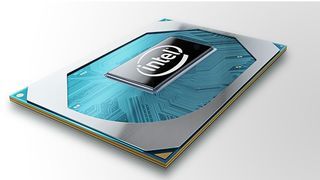Intel Talks Resizable BAR for 11th Gen Rocket Lake CPUs, Laptops
Intel’s already supporting resizable BAR.

As usual, Intel’s poised for a busy year. The company has already launched its new 11th Generation Tiger Lake H35 mobile chips, and 11th Gen Rocket Lake should blast into the market this year to take on the likes of AMD Ryzen 5000. This week during The Tom’s Hardware Show, Intel also discussed the role resizable BAR is playing in its efforts to boost performance for gamers opting for those chips.
Through an advanced feature available through PCIe , resizable BAR lightens the burden on a GPU’s VRAM by only transferring data, like shaders and textures, when needed and, if there are multiple requests, simultaneously. This should boost gaming performance by allowing the CPU to “efficiently access the entire frame buffer,” as Nvidia put it. AMD already tackles this with its Smart Access Memory (SAM) feature available with Radeon RX 6000 graphics cards, but Nvidia added support for RTX 30-series mobile cards in January, with desktop graphics card support beginning in March.
Intel’s GM of premium and gaming notebook segments, Fredrik Hamberger, got into support for resizable BAR on The Tom’s Hardware Show, saying Intel collaborated with graphics card makers, namely Nvidia and AMD, for implementation. The goal, he said was a “standard solution” that could be compatible with multiple vendors.
Intel’s H35-series mobile chips, which target ultraportable gaming laptops, already support resizable BAR, as do all of Intel’s Comet Lake-H series chips and the upcoming H45 series, Hamberger said. It’s just up to the laptop and graphics card makers to make the feature usable.
“The final drivers, from our side, it's already there,” Hamberger told Tom’s Hardware. “Some of the OEMs are working on finalizing exact timing on when they have the driver from the graphics vendors, so I think you'd have to ask them on the exact timing.”
The exec also pointed to some games seeing performance gains of 5-10%.
“It is a pretty nice boost by just turning on this pipeline and, again, standard implementation versus trying to do something custom and proprietary,” Hamberger said.
Stay on the Cutting Edge
Join the experts who read Tom's Hardware for the inside track on enthusiast PC tech news — and have for over 25 years. We'll send breaking news and in-depth reviews of CPUs, GPUs, AI, maker hardware and more straight to your inbox.
Of course, the more games that support resizable BAR, the better. But Hamberger has confidence that we’ll see a growing number of game developers make that possible.
“It’s a pretty late feature that … is being turned on, but since it’s following a standard, I think that the nice thing is if you’re a developer you don’t have to worry about it being like, ‘Hey, [only] these three systems have it.’ It’s gonna be available both on notebooks ... it’s part of our Rocket Lake platform as well on the desktop side,” Hamberger said.
“Our expectation is that you'll see more and more developers turn on the ability to use this, and we’ll continue to scale it.”
You can enjoy this week's episode of The Tom's Hardware Show via the video above, on YouTube, Facebook, or wherever you get your podcasts.
Scharon Harding has a special affinity for gaming peripherals (especially monitors), laptops and virtual reality. Previously, she covered business technology, including hardware, software, cyber security, cloud and other IT happenings, at Channelnomics, with bylines at CRN UK.
-
waltc3 The resizable bar is easy-peasy. The magic ingredient, however, is GPU and GPU driver support to take advantage of a resized bar. Without that, enabling the resizable bar in your bios will not increase your gaming frame-rate performance as the GPU drivers and GPU will still be restricted to 256MBs.Reply
Most Popular


